Overcoming Jet Lag and Travel Fatigue
Whether you are travelling for business or returning from holiday, jet lag and travel fatigue can often accompany long journeys, making it more challenging to get back to your usual routine.
Let’s explore how to prevent or reduce the symptoms of jet lag and travel fatigue.
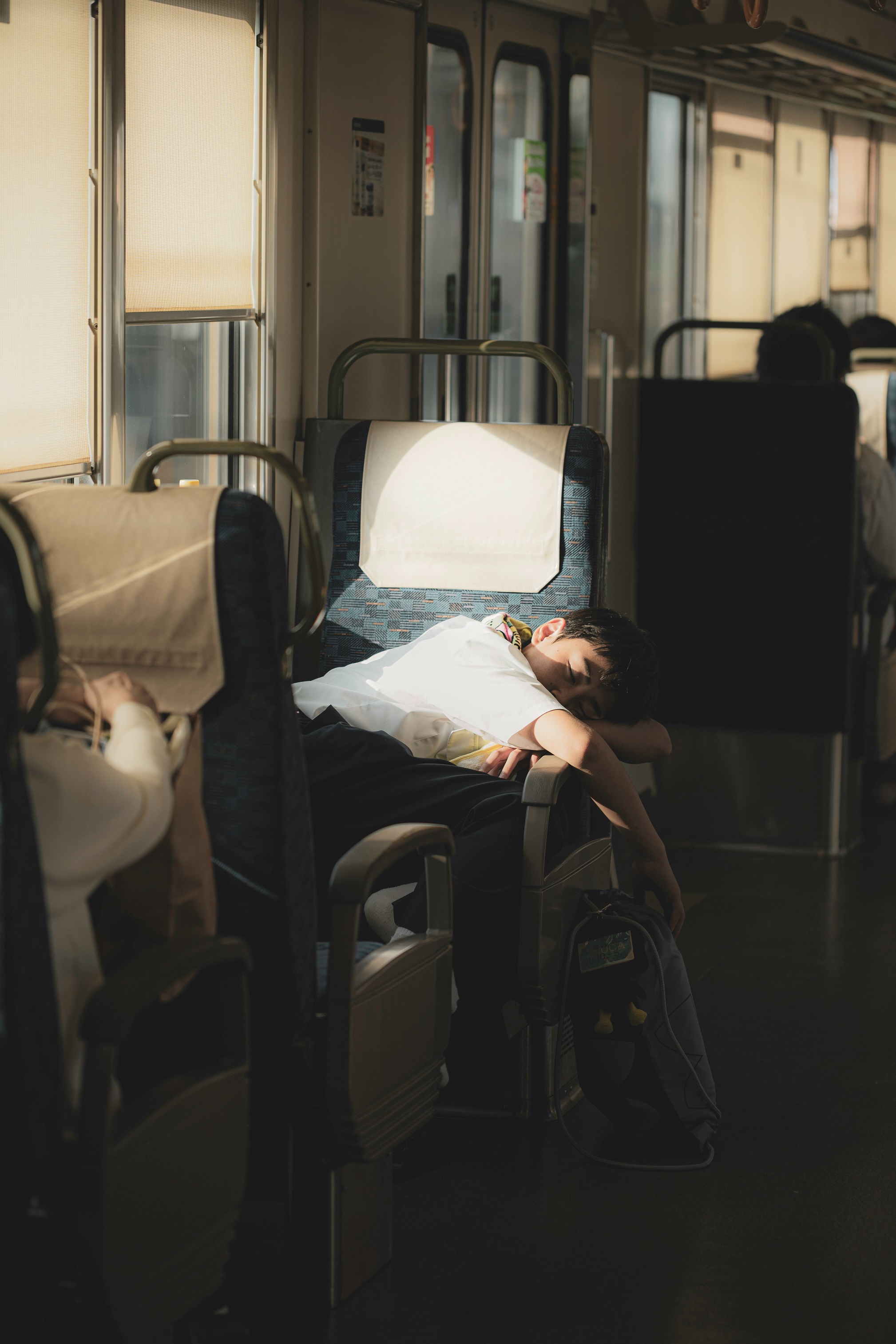
What is Jet Lag?
Jet lag is a temporary sleep disorder that can occur after travelling across two or more time zones. It results from a misalignment between your internal circadian clock - your body’s natural rhythm - and the sleep/wake schedule of your destination. This happens because your circadian clock remains synchronised with the time zone of your departure location.
Common symptoms of jet lag include:
• Increased daytime fatigue or sleepiness
• Difficulty sleeping at night
• Poor mental and physical performance
• Low mood
• Gastrointestinal disturbances (e.g., constipation or diarrhoea)
The likelihood of experiencing jet lag increases with the number of time zones crossed.
Light exposure, (discussed in detail below) is the most powerful environmental cue for resetting your circadian rhythm; additionally social interaction, physical activity, and eating patterns also play a role.
What is Travel Fatigue?
Travel fatigue is temporary exhaustion that can occur during or after travel, even without crossing time zones. It may also cause headaches or reduced concentration.
Contributing factors include:
- Long journeys
- Extended transit times
- Poor sleep before and during travel
- Irregular mealtimes
- Physical discomfort (e.g., prolonged sitting)
Tips for dealing with Jet Lag and Travel Fatigue
- Rest well before travelling - Sleep deprivation before travel can intensify jet lag and fatigue.
- Gradually shift your sleep schedule - Try to adjust your sleep and wake times a few days before and on the day of travel to move more towards your destination’s time zone, if practical.
- Stay well hydrated - Air travel can contribute to dehydration. Hydrate with water and herbal teas.
- Avoid alcohol - Avoid alcohol during travel as this can impact the quality of your sleep and contribute to dehydration.
- Choose healthy snacks - Avoid salty and sugary snacks; opt for fruits and vegetable sticks to avoid gastrointestinal disturbances.
- Limit caffeine - Caffeine can interfere with sleep. If consumed, limit intake and avoid it at least 8 hours before your desired bedtime.
- Move and stretch - Stretch, stand, and walk during flights to prevent muscle aches, joint stiffness and to reduce the risk of blood clots.
- Use sleep aids - Eye masks and earplugs can help if your flight coincides with your sleep schedule.
- Manage light exposure - Timed exposure and avoidance of bright light after arrival is one of the most effective ways to reset your circadian clock. The timing depends on your travel direction and sleep schedule. The section below on “Timed exposure and avoidance of bright light” describes this in more detail.
- Align mealtimes - Start adjusting your mealtimes on the day of travel to match your destination’s schedule as close as possible. This will also help to reset your circadian clock.
- Prioritise your tasks and social meetings - Avoid overloading your calendar in the first few days after arrival to prevent exhaustion.
- Incorporate Exercise – Engage in moderate-intensity exercise, such as brisk walking; this can support the adjustment of your circadian rhythm. Aim to exercise during the same hours recommended for light exposure, as outlined in the section below.
Can napping be helpful?
Short naps may help with improving alertness; however, the timing and length of naps is crucial to ensure it does not interfere with your main sleep at night. If you choose to nap, limit it to 20 - 30 minutes, and ensure it is at least 8 hours before your desired bedtime.
Timed Exposure and Avoidance of Bright Light
Timed light exposure is one of the most effective ways to re-align your circadian clock. However, the direction of travel and number of time zones crossed will influence the ideal window for light exposure and avoidance.
Travelling East vs. Travelling West
- When travelling east, you need to advance your sleep schedule - go to bed and wake up earlier.
- When travelling west, you need to delay your sleep schedule - go to bed and wake up later.
Most people find eastward travel more difficult to adjust to than westward travel. This is because our internal biological clock is slightly longer than 24 hours, making it easier to delay sleep than to advance it.
For trips longer than 1–3 days, it’s beneficial to re-align your circadian clock to the destination time zone.
While it’s commonly believed that maximising light exposure at your destination helps with adjustment, exposing yourself to bright light at the wrong time can worsen jet lag symptoms. To determine the correct timing for light exposure and avoidance, you need to estimate the timing of your minimum core body temperature.
What is Minimum Core Body Temperature (CBT)?
Minimum CBT is when your core body temperature is at its lowest point over a 24-hour cycle. This typically occurs during sleep and is the time when you feel the sleepiest if you are awake.
On a regular sleep schedule, your minimum CBT occurs 2 to 3 hours before your usual wake-up time. If you sleep 7 hours or less, your minimum CBT is approximately 2 hours before waking; if you sleep more than 7 hours, your minimum CBT is approximately 3 hours before waking.
Light exposure effects:
- Light exposure in the 12 hours before minimum CBT and light avoidance in the 12 hours after minimum CBT: delays your circadian clock - helps with westward travel.
- Light exposurein the 12 hours after minimum CBT and light avoidance in the 12 hours before minimum CBT: advances your circadian clock - helps with eastward travel.
The most effective window is 3 to 6 hours before or after your minimum CBT to delay or advance your circadian clock.
The impact of light exposure increases with both the duration and intensity, with natural daylight being the most effective. Even on a cloudy day or in a shaded outdoor area, light intensity is significantly higher than typical indoor lighting. However, it is important to avoid looking directly at bright light that causes any discomfort or strain to your eyes.
Light from electronic devices, such as laptops or mobile phones can also interfere with your circadian rhythm. It is therefore best to avoid use of devices during the recommended times for avoidance of bright light.
Daily Shifts to Minimum CBT Timing
When travelling eastward, the timing of your minimum CBT advances by about 1 hour per day, and your recommended light exposure and avoidance times will similarly advance by about 1 hour daily.
Conversely, with westward travel, the timing of your minimum CBT is delayed by about 2 hours per day. As a result, your ideal times for exposure to and avoidance of bright light will also shift later by approximately 2 hours each day.
Example for Eastward Travel – Dubai to Japan (5 hours east)
Normal sleep schedule in Dubai: 11:30pm to 6:00am
Goal: Advance your body clock to achieve the same sleep schedule in Japan.
- Calculate minimum CBT at home:
6.5 hours sleep from 11:30pm – 6:00am → minimum CBT ≈ 4:00am Dubai time.
- Convert minimum CBT to destination time:
Japan is 5 hours ahead → minimum CBT ≈ 9:00am Japan time on day 1.
- Daily adjustment: minimum CBT will advance by ~1 hour per day, so adjust light exposure and avoidance accordingly.
Light avoidance and exposure for Days 1 to 6 at your destination in Japan are illustrated in Figures 1 to 6, using 24-hour clocks.
Since the most impactful window for managing light avoidance and exposure is within the 3 to 6 hours before and after the minimum CBT, the diagrams highlight light strategies during the 6-hour period on either side of the minimum CBT.
Figures 1 to 6: Figures 1 to 6 present a visual guide for managing circadian adjustment when travelling 5 hours east from Dubai to Japan. Each 24-hour clock illustrates the recommended timings for light avoidance and light exposure over six days, based on the expected daily advancement of minimum core body temperature (CBT) by one hour. Blue shading represents the desired sleep schedule from 11:30pm to 6:00am. The minimum CBT advances by one hour each day as represented by the red arrow. Yellow shading marks the most impactful period for light exposure outside your sleeping window - six hours after minimum CBT. Black shading represents the most impactful period for light avoidance outside your sleeping window - six hours before minimum CBT.

- Figure 1: Day 1 at Japan
- Figure 2: Day 2 at Japan
- Figure 3: Day 3 at Japan
- Figure 4: Day 4 at Japan
- Figure 5: Day 5 at Japan
- Figure 6: Day 6 at Japan
Figure 1: Day 1 at Japan
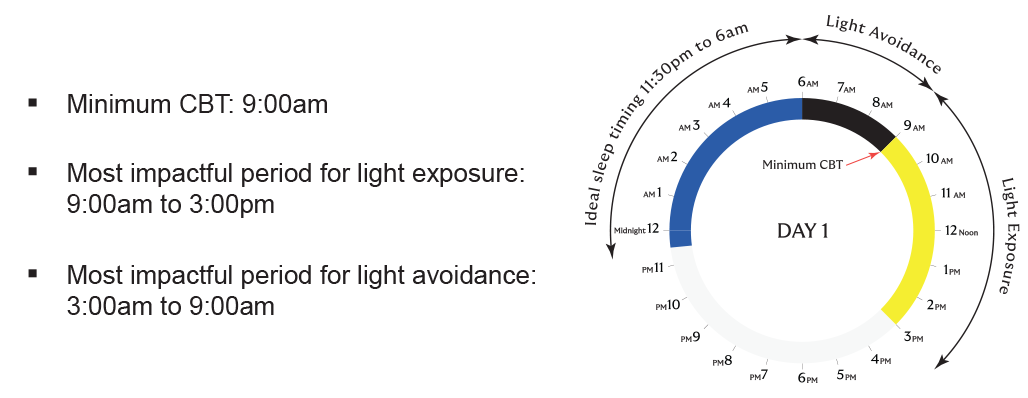
Figure 2: Day 2 at Japan
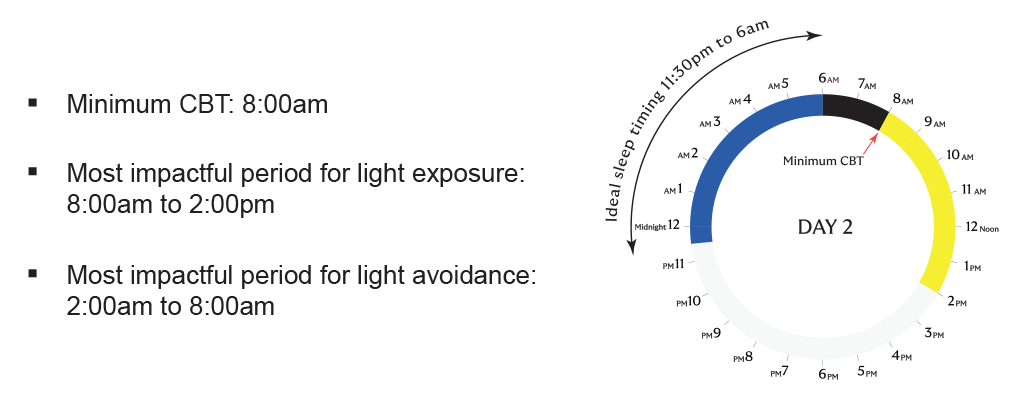
Figure 3: Day 3 at Japan
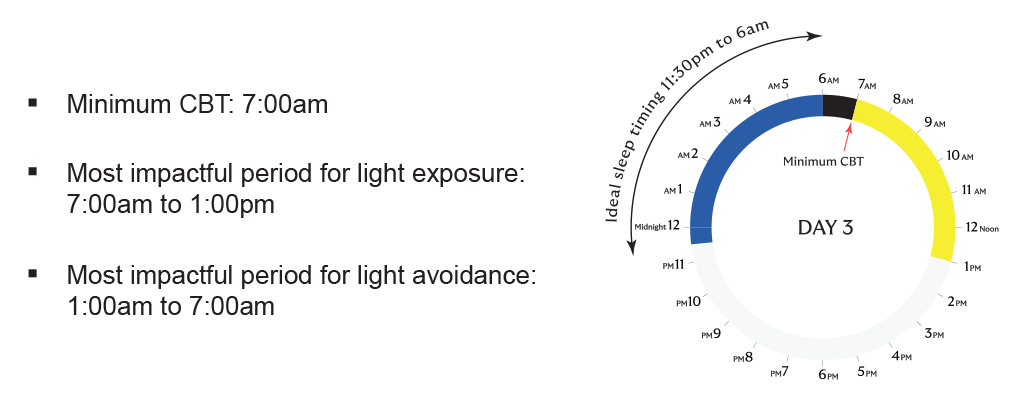
Figure 4: Day 4 at Japan
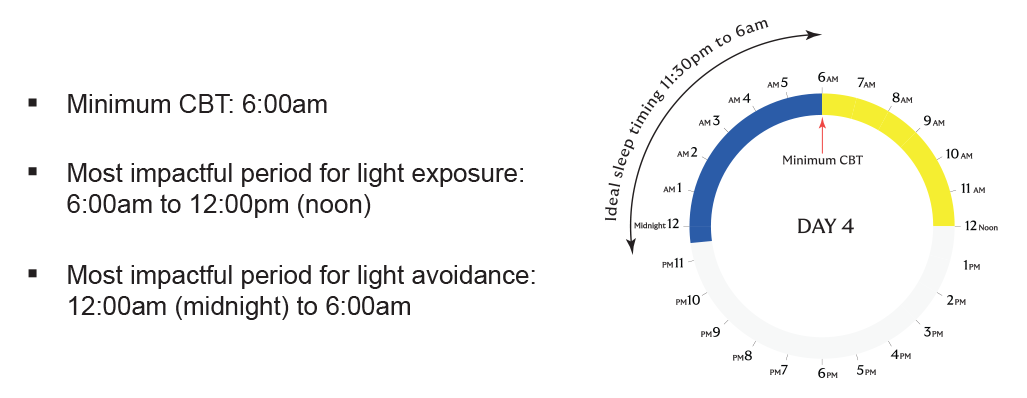
Figure 5: Day 5 at Japan
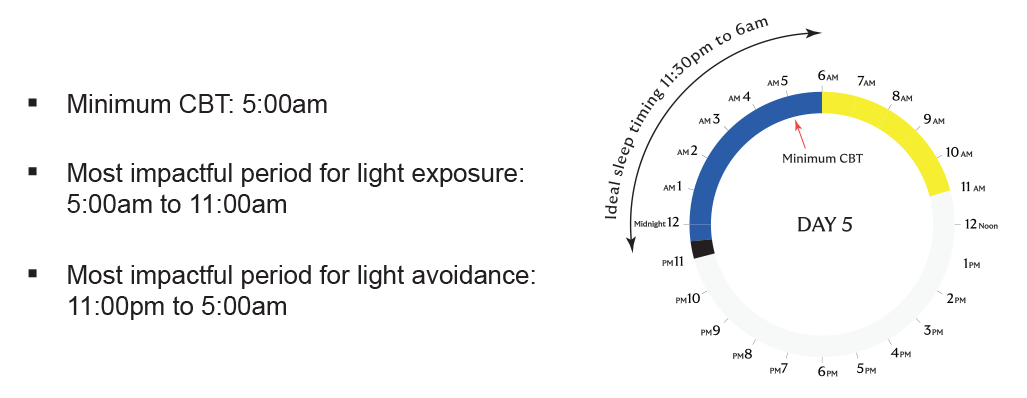
Figure 6: Day 6 at Japan
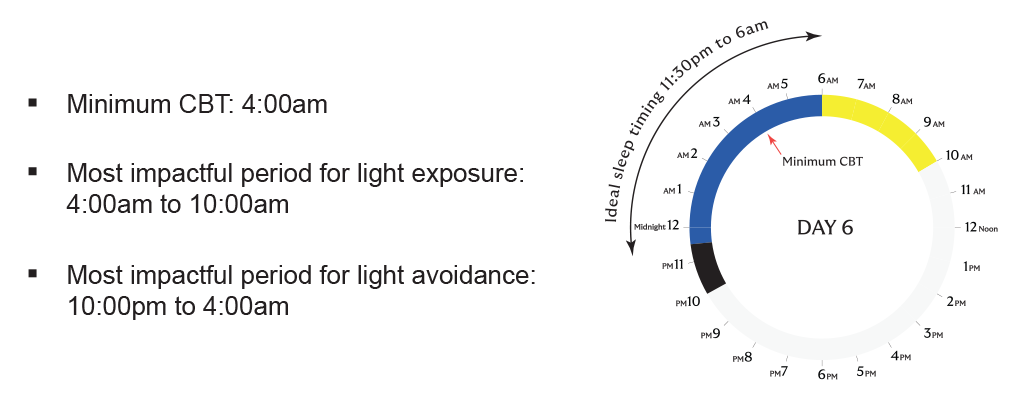
By Day 6, the minimum CBT occurs at the ideal time of 4:00am, which matches your pre-travel minimum CBT. This aligns with your desired sleep schedule of 11:30pm to 6:00am, indicating that your body clock is fully adapted. At this point, tiredness and other symptoms of jet lag should have completely subsided.
Practical considerations
On day 1, if your flight lands at 5:00am, you will need to avoid light exposure until 9:00am, as illustrated above in Figure 1. Effective strategies for light avoidance include wearing dark sunglasses during your journey from the airport to the hotel and staying in a dark room until 9:00am, if feasible. During the flight, using an eye mask and avoiding blue-light emitting screens can further minimise early light exposure, especially during your intended sleep period based on Japan time.
On the days following your arrival, if you happen to be awake during your desired sleep schedule, it is important to remain in a dark environment and continue avoiding light exposure during these hours.
These small adjustments can make a significant difference in how quickly and comfortably you adapt to the new schedule.
Eastward Travel Across More Than 8 Time Zones
When travelling eastward across more than 8 time zones, it may be more effective to delay your body clock, as you would for westward travel. This approach can lead to a faster and more manageable adjustment, as the body is naturally better at delaying its circadian rhythm, by up to 2 hours per day, compared to advancing it, which typically occurs at a rate of only 1 hour per day. Choosing to delay rather than advance your body clock in these cases can significantly reduce jet lag and improve overall adaptation to the new time zone.
Westward travel
To support the delay of your body clock when travelling west, apply the principle of light exposure during the 3 to 6 hours before your minimum CBT, and light avoidance during the 3 to 6 hours after your minimum CBT.
With westward travel, your minimum CBT typically delays by approximately two hours per day, meaning the optimal windows for light exposure and avoidance also shift by two hours daily. Therefore, if you are travelling six hours west, for example, it generally takes about four days to fully adapt to the new time zone.
Note: It is important to avoid interfering with your main sleep period, even if it overlaps with the ideal light exposure window.
Practical tip
After travelling west, you may find yourself waking up very early, as your circadian clock remains aligned with your home time zone. To help your body adjust, stay in a dark room and avoid bright light exposure until your ideal wake-up time. This supports the gradual delay of your body clock and helps you transition more smoothly to the new schedule.
Still Struggling with Jet Lag?
If you travel frequently and continue to experience jet lag despite following these strategies, consider discussing further options with a healthcare professional.
Any questions?
If you have any questions or comments, please write to us on employeebenefits.mea@howdengroup.com
References
- Eastman CI, Burgess HJ. How To Travel the World Without Jet lag. Sleep Med Clin. 2009;4(2):241-255. doi:10.1016/j.jsmc.2009.02.006
- Jet Lag Disorder | Yellow Book | CDC
- Roach GD, Sargent C. Interventions to Minimize Jet Lag After Westward and Eastward Flight. Front Physiol. 2019;10:927. Published 2019 Jul 31. doi:10.3389/fphys.2019.00927
- How to Get Over Jet Lag: Tips, Suggestions, and Treatments | Sleep Foundation
- Eastman, Charmane & Crowley, Stephanie & Revell, Victoria. Light and melatonin treatment for jet lag. Encyclopedia of Sleep and Circadian Rhythms. 2023.
Disclaimer:
The content in this article is for general informational purpose and is not meant to replace or substitute for professional medical advice, diagnosis or treatment. Always consult a qualified healthcare professional with any questions or concerns about your health.